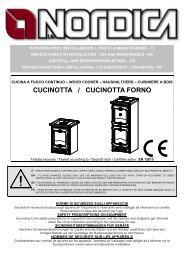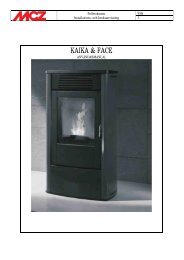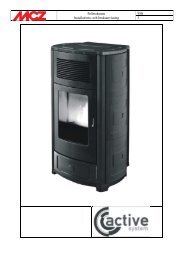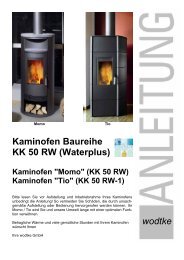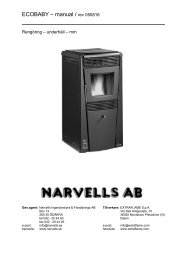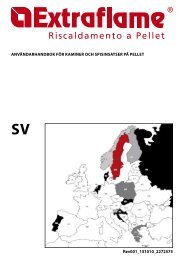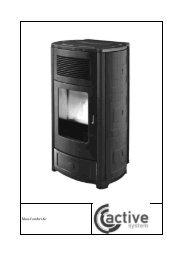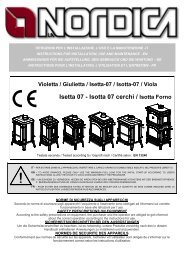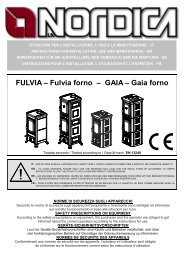TERMOROSA TR-02 - Narvells
TERMOROSA TR-02 - Narvells
TERMOROSA TR-02 - Narvells
Create successful ePaper yourself
Turn your PDF publications into a flip-book with our unique Google optimized e-Paper software.
12. CORRECT USE FOR CEN<strong>TR</strong>AL HEATING.<br />
Wood burning stove/cooker – <strong>TERMOROSA</strong> <strong>TR</strong><strong>02</strong><br />
To obtain the best results in using the appliance for central heating it is necessary to have a few basic<br />
concepts clear.<br />
The system works very well only when it has arrived at its operating regime and the pump is always in<br />
operation; only in this condition the water coming from the system will be hot enough to avoid phenomena<br />
of condensation within the boiler body; if, on the contrary, the system is managed at a power that is too<br />
low, the system will tend to function intermittently.<br />
In effect the pump will function only for short periods and only when the water exceeds 70°C but, each time<br />
the cold water that returns from the system will have dropped the temperature below this limit, this will stop<br />
waiting for it to return to 70°C.<br />
During these pause periods the water of the radiators will tend to cool down returning cold to the boiler<br />
when the pump will be able to start again.<br />
With this method of operation the radiators will always be cold in the lower part and the lower part of the<br />
boiler body will remain always almost cold causing condensation of the smoke and acid vapours which, in<br />
the long run could cause its corrosion.<br />
To avoid this serious inconvenience it will be necessary to regulate the combustion air so that the heat<br />
generated is able to keep the pump constantly in operation; only in this way will it be possible to heat the<br />
radiators constantly allowing hot water to return to the boiler to avoid condensation of smoke and<br />
consequent corrosion.<br />
To achieve this result it will be necessary to regulate the primary air shutter (door of ash chamber) to 1/3 of<br />
its opening. The secondary air (above the door of the furnace) all open, while the knob of the thermostat<br />
shutter placed under the door of the oven should be regulated so the water temperature in the boiler<br />
stabilises between 70-80°C operating in the followi ng way.<br />
If regulating the shutter to position 3 after a few hours of operation the water temperature will have not<br />
stabilised itself allowing a continuous operation of the pump, it will be necessary to increase the opening<br />
trying to set it at position 5.<br />
If in position 5 the temperature arrives at 80-85°C after a short time, it will be better to bring the regulation<br />
to position 4 because it would be excessive, if instead it stabilises between 70 and 80°C it will be ideal and<br />
can always be kept in that position.<br />
13. NO ELEC<strong>TR</strong>ICITY<br />
If there is a sudden blackout during normal operation of the system, it will be necessary to perform these<br />
simple actions to avoid boiling water following lack of operation of the pump.<br />
1 Lift the movable grill of the furnace to the highest point to reduce the surface of exchange exposed to<br />
the heat of the flame.<br />
2 Close the registers of the primary and secondary air and bring the knob of the modulating thermostat<br />
fixed on the right part of the back of the wood burning stove/cooker into position 0. This blocks the<br />
entry of comburent air completely.<br />
3 Open the oven door to encourage dispersal of internal heat.<br />
4 Open the smoke register pressing the knob placed on the right side of the frame; in this way the<br />
residual heat still produced will be diverted to the chimney.<br />
14. OPERATION IN <strong>TR</strong>ANSITION PERIODS<br />
WARNING: For no reason turn on the fire before the system has been completely filled with water;<br />
doing so could cause serious damage to the entire structure. The system should be kept<br />
constantly full of water even in periods in which the use of the wood burning stove/cooker is<br />
not required. During winter any non activity should involve the addition of anti- freeze.<br />
During transition periods when the external temperatures are higher, if there is a sudden increase of<br />
temperature it can happen that the combustion gases inside the flue cannot be completely sucked up.<br />
The exhaust gases do not come out completely (intense smell of gas). In this case, shake the grating more<br />
frequently and increase the air for the combustion. Then, load a reduced quantity of fuel in order to permit a<br />
rapid burning (growing up of the flames) and the stabilization of the draught.<br />
Then, check that all openings for the cleaning and the connections to the stack are air-tight.<br />
32 Installation, user and maintenance instructions – EN – Rev.07




